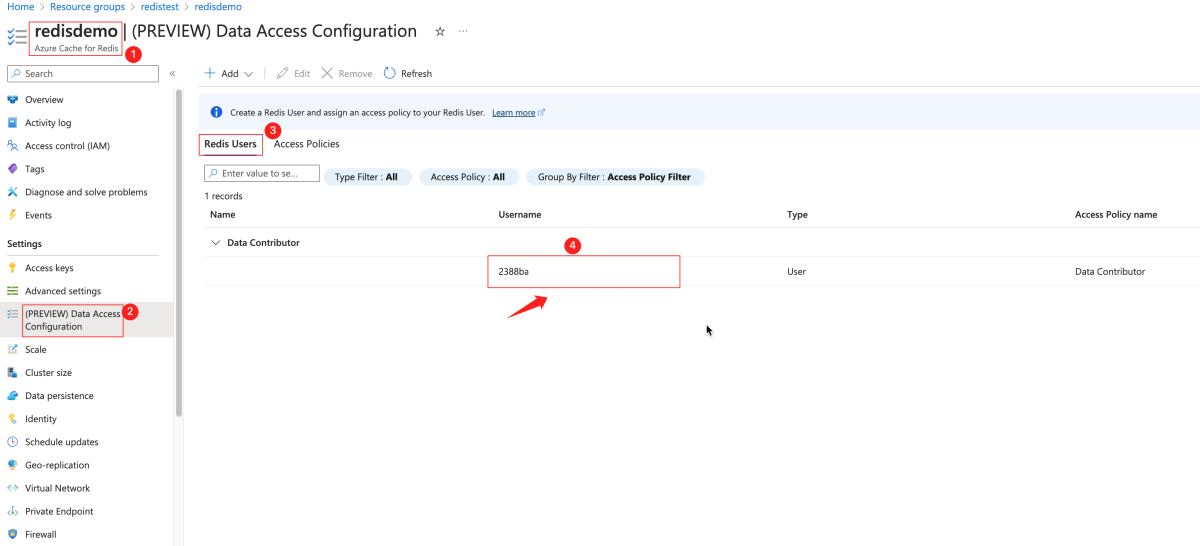Note
Access to this page requires authorization. You can try signing in or changing directories.
Access to this page requires authorization. You can try changing directories.
In this quickstart, you incorporate Azure Cache for Redis into a Java app using the Redisson Redis client and JCP standard JCache API. These services give you access to a secure, dedicated cache that is accessible from any application within Azure. This article provides two options for selecting the Azure identity to use for the Redis connection.
This quickstart uses the Maven archetype feature to generate the scaffolding for the app. The quickstart directs you to modify the generated code to arrive at the working sample app. If you want to skip straight to the completed code, see the Java quickstart on GitHub.
- Azure subscription - create one
- Use Microsoft Entra ID for cache authentication
- Apache Maven
To create an Azure Managed Redis (preview) instance, sign in to the Azure portal and select Create a resource.
On the New page, in the search box type Azure Cache for Redis.
On the New Redis Cache page, configure the settings for your new cache.
Setting Choose a value Description Subscription Drop down and select your subscription. The subscription under which to create this new Azure Managed Redis instance. Resource group Drop down and select a resource group, or select Create new and enter a new resource group name. Name for the resource group in which to create your cache and other resources. By putting all your app resources in one resource group, you can easily manage or delete them together. DNS name Enter a name that is unique in the region. The cache name must be a string between 1 and 63 characters when combined with the cache's region name that contain only numbers, letters, or hyphens. (If the cache name is fewer than 45 characters long it should work in all currently available regions.) The name must start and end with a number or letter, and can't contain consecutive hyphens. Your cache instance's host name is \<DNS name\>.\<Azure region\>.redis.chinacloudapi.cn.Location Drop down and select a location. Azure Managed Redis is available in selected Azure regions. Cache type Drop down and select the performance tier and cache size. The tier determines the performance of the Redis instance, while the cache size determines the memory available to store data. For guidance on choosing the right performance tier, see Choosing the right tier 
Select Next: Networking and select either a public or private endpoint.
Select Next: Advanced.
Configure any Redis modules you want to add to the instance.
By default, for a new managed cache:
- Microsoft Entra ID is enabled.
- Access Keys Authentication is disabled for security reasons.
Important
For optimal security, we recommend that you use Microsoft Entra ID with managed identities to authorize requests against your cache if possible. Authorization by using Microsoft Entra ID and managed identities provides superior security and ease of use over shared access key authorization. For more information about using managed identities with your cache, see Use Microsoft Entra ID for cache authentication.
Set Clustering policy to Enterprise for a nonclustered cache, or to OSS for a clustered cache. For more information on choosing Clustering policy, see Cluster policy.

If you're using Active geo-replication, it must be configured during creation. For more information, see Configure active geo-replication for Azure Managed Redis instances.
Important
You can't change the clustering policy of an Azure Managed Redis (preview) instance after you create it. If you're using RediSearch, the Enterprise cluster policy is required, and
NoEvictionis the only eviction policy supported.Important
If you're using this cache instance in a geo-replication group, eviction policies cannot be changed after the instance is created. Be sure to know the eviction policies of your primary nodes before you create the cache. For more information on active geo-replication, see Active geo-replication prerequisites.
Important
You can't change modules after you create a cache instance. Modules must be enabled at the time you create an Azure Cache for Redis instance. There is no option to enable the configuration of a module after you create a cache.
Select Next: Tags and skip.
Select Next: Review + create.
Review the settings and select Create.
It takes several minutes for the Redis instance to create. You can monitor progress on the Azure Managed Redis Overview page. When Status shows as Running, the cache is ready to use.
To create a cache, sign in to the Azure portal and select Create a resource.

On the Get Started page, type Azure Cache for Redis in the search box. Then, select Create.
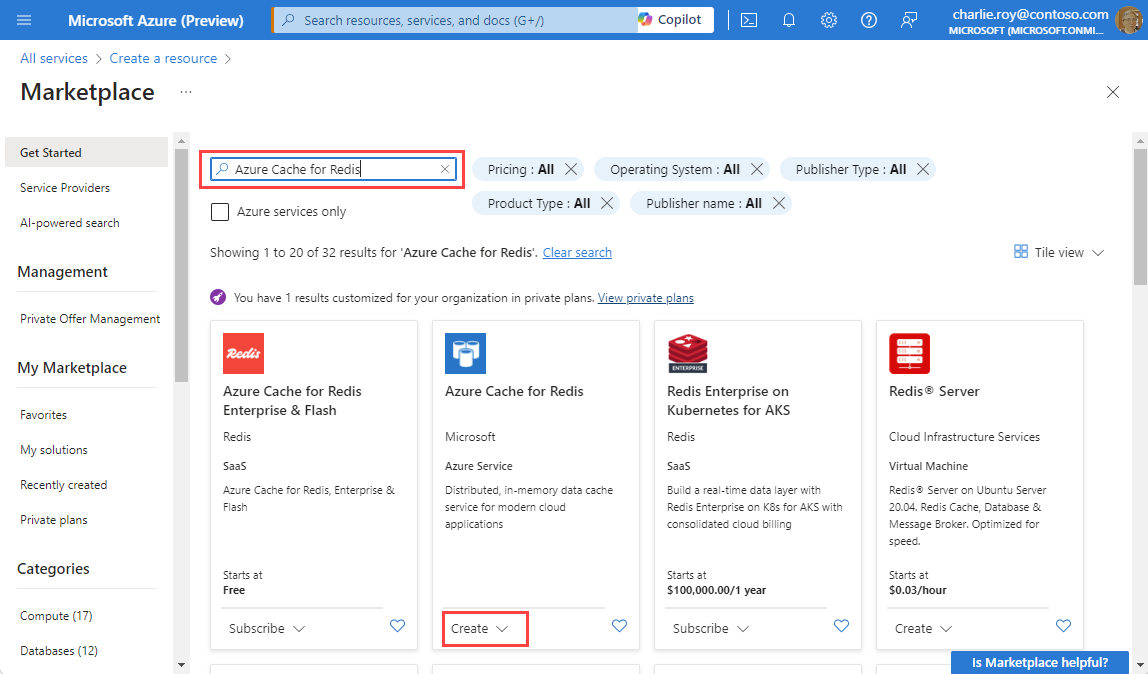
On the New Redis Cache page, configure the settings for your cache.
Setting Choose a value Description Subscription Drop down and select your subscription. The subscription under which to create this new Azure Cache for Redis instance. Resource group Drop down and select a resource group, or select Create new and enter a new resource group name. Name for the resource group in which to create your cache and other resources. By putting all your app resources in one resource group, you can easily manage or delete them together. DNS name Enter a unique name. The cache name must be a string between 1 and 63 characters that contain only numbers, letters, or hyphens. The name must start and end with a number or letter, and can't contain consecutive hyphens. Your cache instance's host name is <DNS name>.redis.cache.chinacloudapi.cn. Location Drop down and select a location. Select a region near other services that use your cache. Cache SKU Drop down and select a SKU. The SKU determines the size, performance, and features parameters that are available for the cache. For more information, see Azure Cache for Redis Overview. Cache size Drop down and select a size of your cache For more information, see Azure Cache for Redis Overview. Select the Networking tab or select the Networking button at the bottom of the page.
In the Networking tab, select your connectivity method.
Select the Next: Advanced tab or select the Next: Advanced button on the bottom of the page to see the Advanced tab.
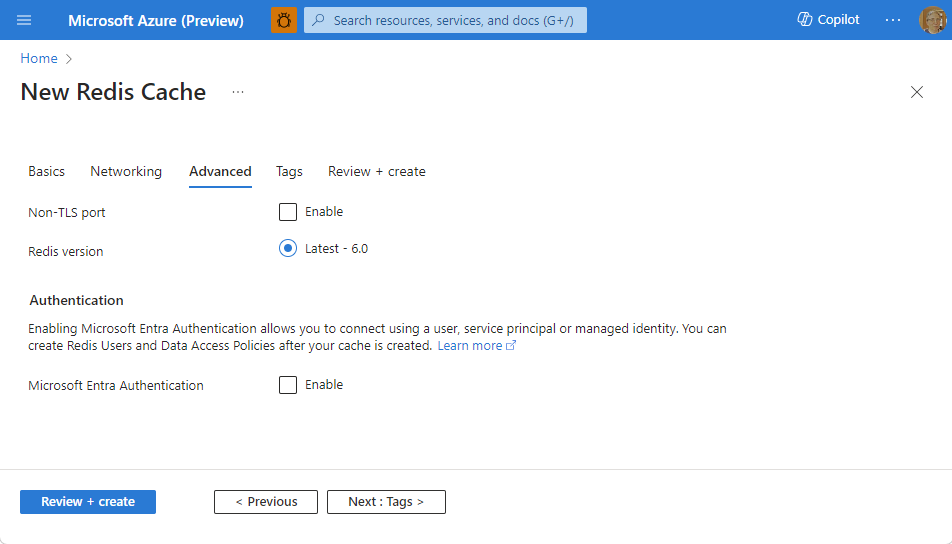
- For Basic or Standard caches, toggle the selection for a non-TLS port. You can also select if you want to enable Microsoft Entra Authentication.
- For a Premium cache, configure the settings for non-TLS port, clustering, managed identity, and data persistence. You can also select if you want to enable Microsoft Entra Authentication.
Select the Next: Tags tab or select the Next: Tags button at the bottom of the page.
Optionally, in the Tags tab, enter the name and value if you wish to categorize the resource.
Select Review + create. You're taken to the Review + create tab where Azure validates your configuration.
After the green Validation passed message appears, select Create.
It takes a while for a cache to create. You can monitor progress on the Azure Cache for Redis Overview page. When Status shows as Running, the cache is ready to use.
To connect your Azure Cache for Redis server, the cache client needs the host name, ports, and a key for the cache. Some clients might refer to these items by slightly different names. You can get the host name, ports, and keys from the Azure portal.
To get the host name and ports for your cache, select Overview from the Resource menu. The host name is of the form
<DNS name>.redis.cache.chinacloudapi.cn.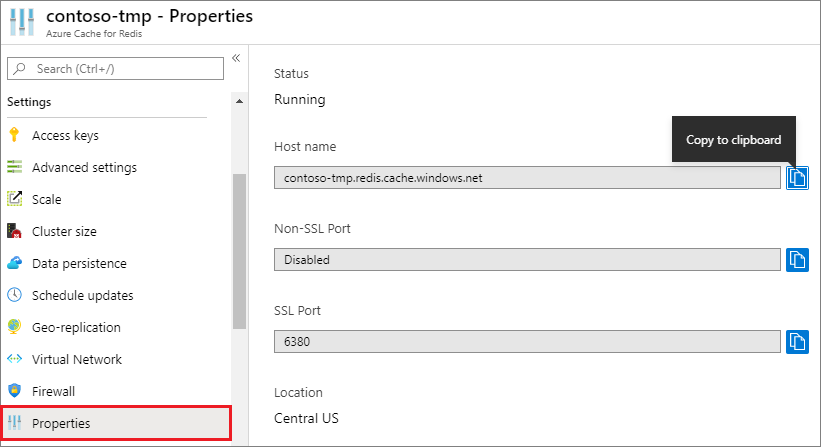
To get the access keys, select Authentication from the Resource menu. Then, select the Access keys tab.
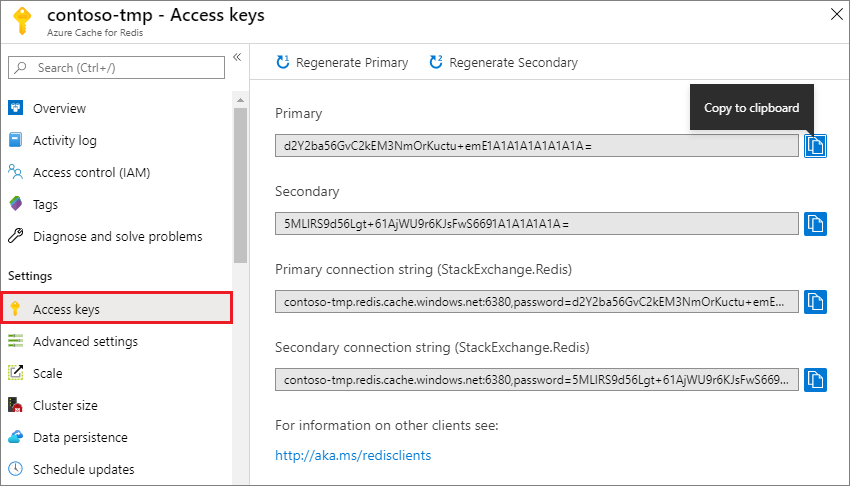
The following steps show you how to set up the working environment for the Java app. You can choose to authenticate with Azure Cache for Redis using Microsoft Entra ID (recommended) or access keys.
export REDIS_CACHE_HOSTNAME=<your-host-name>.redis.cache.chinacloudapi.cn
export USER_NAME=<user-name>
export REDIS_CACHE_PORT=10000
export REDIS_CACHE_HOSTNAME=<your-host-name>.redis.cache.chinacloudapi.cn
export USER_NAME=<user-name>
export REDIS_CACHE_PORT=6380
Replace the placeholders with the following values:
<your-host-name>: The DNS host name. To get the host name and ports for your cache, select Overview from the Resource menu. The host name is of the form<DNS name>.redis.cache.chinacloudapi.cn.
<user-name>: Object ID of your managed identity or service principal.You can get the user name by using the following steps:
Use Maven to generate a new quickstart app:
mvn archetype:generate \ -DarchetypeGroupId=org.apache.maven.archetypes \ -DarchetypeArtifactId=maven-archetype-quickstart \ -DarchetypeVersion=1.3 \ -DinteractiveMode=false \ -DgroupId=example.demo \ -DartifactId=redis-redisson-test \ -Dversion=1.0Change to the new redis-redisson-test project directory.
Open the pom.xml file and add a dependency for Redisson:
<dependency> <groupId>com.azure</groupId> <artifactId>azure-identity</artifactId> <version>1.15.0</version> <!-- {x-version-update;com.azure:azure-identity;dependency} --> </dependency> <dependency> <groupId>org.redisson</groupId> <artifactId>redisson</artifactId> <version>3.36.0</version> <!-- {x-version-update;org.redisson:redisson;external_dependency} --> </dependency>Save the pom.xml file.
Open App.java and replace the code with the following code:
package example.demo; import com.azure.core.credential.TokenRequestContext; import com.azure.identity.DefaultAzureCredential; import com.azure.identity.DefaultAzureCredentialBuilder; import org.redisson.Redisson; import org.redisson.api.RedissonClient; import org.redisson.config.Config; import org.redisson.jcache.configuration.RedissonConfiguration; import javax.cache.Cache; import javax.cache.CacheManager; import javax.cache.Caching; import javax.cache.configuration.Configuration; import javax.cache.configuration.MutableConfiguration; import java.time.LocalDateTime; /** * Redis test * */ public class App { public static void main(String[] args) { Config redissonconfig = getConfig(); RedissonClient redissonClient = Redisson.create(redissonconfig); MutableConfiguration<String, String> jcacheConfig = new MutableConfiguration<>(); Configuration<String, String> config = RedissonConfiguration.fromInstance(redissonClient, jcacheConfig); // Perform cache operations using JCache CacheManager manager = Caching.getCachingProvider().getCacheManager(); Cache<String, String> map = manager.createCache("test", config); // Simple get and put of string data into the cache System.out.println("\nCache Command : GET Message"); System.out.println("Cache Response : " + map.get("Message")); System.out.println("\nCache Command : SET Message"); map.put("Message", String.format("Hello! The cache is working from Java! %s", LocalDateTime.now())); // Demonstrate "SET Message" executed as expected System.out.println("\nCache Command : GET Message"); System.out.println("Cache Response : " + map.get("Message")); redissonClient.shutdown(); } private static Config getConfig() { //Construct a Token Credential from Identity library, e.g. DefaultAzureCredential / ClientSecretCredential / Client CertificateCredential / ManagedIdentityCredential etc. DefaultAzureCredential defaultAzureCredential = new DefaultAzureCredentialBuilder().build(); // Fetch a Microsoft Entra token to be used for authentication. String token = defaultAzureCredential .getToken(new TokenRequestContext() .addScopes("https://redis.azure.com/.default")).block().getToken(); // Connect to the Azure Cache for Redis over the TLS/SSL port using the key Config redissonconfig = new Config(); redissonconfig.useSingleServer() .setAddress(String.format("rediss://%s:%s", System.getenv("REDIS_CACHE_HOSTNAME"), System.getenv("REDIS_CACHE_PORT"))) .setUsername(System.getenv("USER_NAME")) // (Required) Username is Object ID of your managed identity or service principal .setPassword(token); // Microsoft Entra access token as password is required. return redissonconfig; } }Save App.java.
Execute the following Maven command to build and run the app:
mvn compile exec:java -Dexec.mainClass=example.demo.App
In the following output, you can see that the Message key previously had a cached value, which was set in the last run. The app updated that cached value.
Cache Command : GET Message
Cache Response : Hello! The cache is working from Java! 2023-12-05T15:13:11.398873
Cache Command : SET Message
Cache Command : GET Message
Cache Response : Hello! The cache is working from Java! 2023-12-05T15:45:45.748667
If you plan to continue with the next tutorial, you can keep the resources created in this quickstart and reuse them.
Otherwise, if you're finished with the quickstart sample application, you can delete the Azure resources created in this quickstart to avoid charges.
Important
Deleting a resource group is irreversible and that the resource group and all the resources in it are permanently deleted. Make sure that you do not accidentally delete the wrong resource group or resources. If you created the resources for hosting this sample inside an existing resource group that contains resources you want to keep, you can delete each resource individually instead of deleting the resource group.
Sign in to the Azure portal and select Resource groups.
In the Filter by name textbox, type the name of your resource group. The instructions for this article used a resource group named
TestResources. On your resource group in the result list, select Test Resources then Delete resource group.Type the name of your resource group to confirm deletion and then select Delete.
After a few moments, the resource group and all of its contained resources are deleted.
In this quickstart, you learned how to use Azure Cache for Redis from a Java application with Redisson Redis client and JCache. Continue to the next quickstart to use Azure Cache for Redis with an ASP.NET web app.
